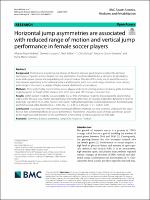Por favor, use este identificador para citar o enlazar este ítem:
https://repositorio.usj.es/handle/123456789/1096
| Título : | Horizontal jump asymmetries are associated with reduced range of motion and vertical jump performance in female soccer players |
| Autor: | Roso-Moliner, Alberto Lozano, Demetrio 


Nobari, Hadi 


Bishop, Chris John 

Cartón-Llorente, Antonio 
Mainer Pardos, Elena 


|
| Palabras clave : | Symmetry; Bilateral asymmetry; Jump; ROM; Injury risk; Football |
| Fecha de publicación: | 8-jul-2023 |
| Editorial : | BMC |
| Citación : | Roso-Moliner A, Lozano D, Nobari H, Bishop C, Carton-Llorente A, Mainer-Pardos E. Horizontal jump asymmetries are associated with reduced range of motion and vertical jump performance in female soccer players. BMC Sports Sci Med Rehabil. 2023 Jul 8;15(1):80. doi: 10.1186/s13102-023-00697-1. PMID: 37422669; PMCID: PMC10329800. |
| Resumen : | Background Performance in jumping and change of direction tests are good proxies to reflect the skill level during soccer-specific actions. Greater inter-leg asymmetries have been identified as a risk factor for developing acute and overuse injuries and jeopardizing soccer performance. The aim of this study was to assess the association between asymmetry in the unilateral vertical and horizontal jump tests, ankle range of motion, linear velocity, and change of direction in a sample of highly trained adult female soccer players. Methods Thirty-eight highly trained female soccer players underwent a testing protocol including ankle dorsiflexion, single leg jumps for height (CMJ), distance (HJ), 40 m sprint and 180° change of direction tests. Results Within-session reliability was acceptable (CV ≤ 7.9%), and relative reliability showed good to excellent (ICC: 0.83 to 0.99). The one-way ANOVA reported higher inter-limb differences for change of direction deficit (10.9 ± 8.04%) and single leg CMJ (5.70 ± 5.22%). Pearson correlations highlighted significant relationships between horizontal jump asymmetries and ankle dorsiflexion (r = -0.41), CMJ (r = - 0.36 to -0.49) and HJ (r = -0.28 to - 0.56). Conclusions Assessing inter-limb asymmetries through different methods can help scientists understand the specificity of their detrimental effects on soccer performance. Practitioners should be aware of these specificities as well as the magnitude and direction of the asymmetries when aiming to improve specific on-field skills. |
| URI : | https://repositorio.usj.es/handle/123456789/1096 |
| ISSN : | 2052-1847 |
| Aparece en las colecciones: | Artículos de revistas |
Ficheros en este ítem:
| Fichero | Descripción | Tamaño | Formato | |
|---|---|---|---|---|
| Horizontal jump asymmetries.pdf | 983,49 kB | Adobe PDF |  Visualizar/Abrir |
Este ítem está sujeto a una licencia Creative Commons Licencia Creative Commons

